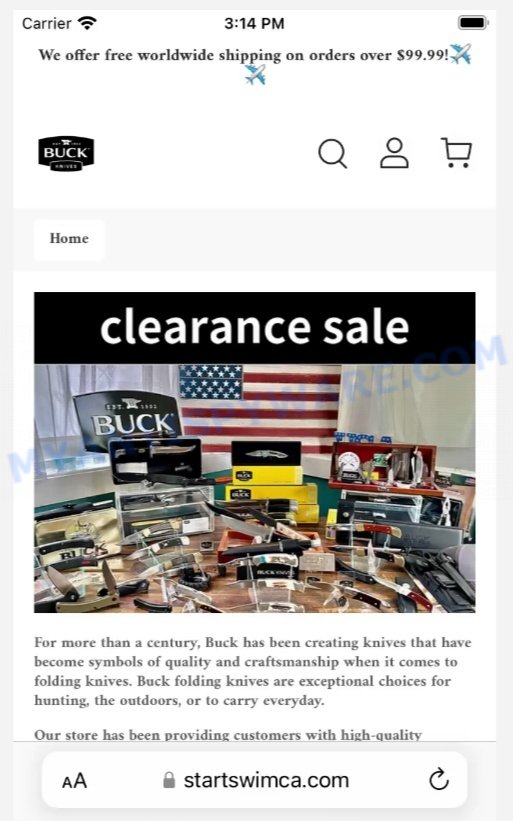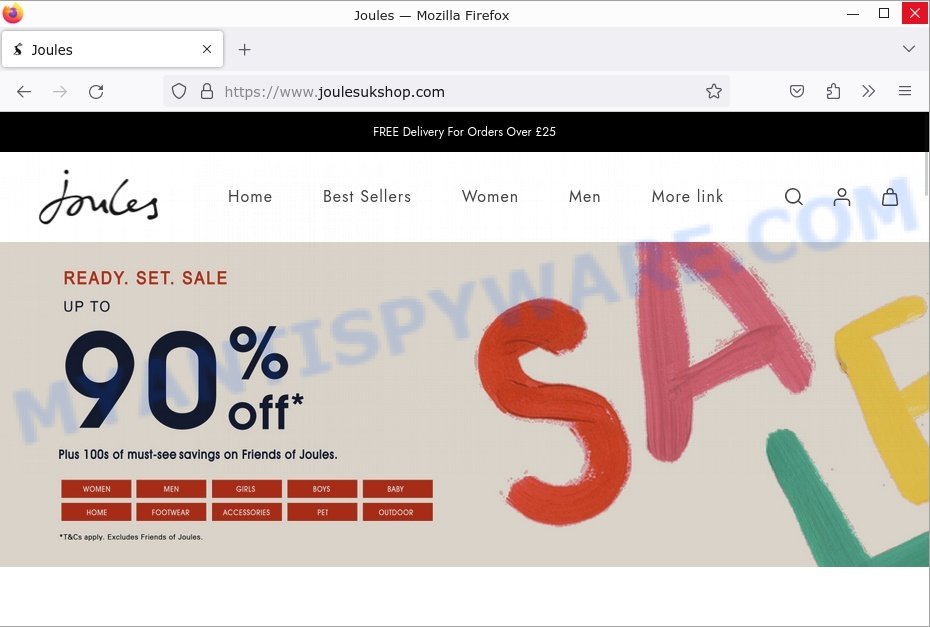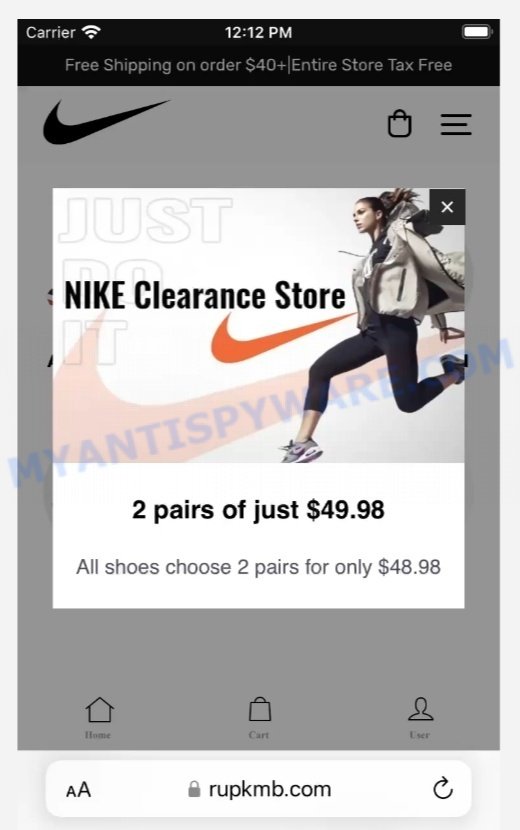Bargain hunters, beware! An emerging online scam cleverly disguises itself under the enticing banner of ‘Clearance Sale: 90% Off,’ especially prevalent on platforms like Facebook. Scammers cunningly create fake online storefronts and employ aggressive marketing tactics to lure in unsuspecting shoppers with irresistibly low prices. Ads that gleam with promises like “Clearance Sale 😍 One-time opportunity! 😍 Up to 90% off on all items! Seize this money-saving chance!” are often too good to be true.
If such ads have caught your attention, it’s crucial to tread with caution. Dive into this in-depth analysis as we unveil the mechanics of these fraudulent schemes, highlight the warning signs, and equip you with the knowledge to safeguard yourself from falling prey.

Table of Contents
How the Clearance Sale Scam Works
The scam often begins with enticing advertisements plastered across social media platforms, email inboxes, or even pop-up ads on websites. These ads promise unbelievable discounts and clearance sales that seem too good to pass up.
Once you click on these enticing ads, you’re directed to what appears to be an e-commerce website. These sites are meticulously designed to mimic the look and feel of legitimate online stores, complete with product listings, shopping carts, and payment gateways. They often use logos, images, and branding that imitate well-known retail companies, creating an illusion of trustworthiness.

As you browse the website, you’ll notice products displayed at extraordinarily low prices. These prices are the bait that lures unsuspecting shoppers in. Believing they’ve stumbled upon an incredible deal, victims proceed to add items to their shopping carts and proceed to the checkout page.
At this point, the scam takes a nefarious turn. When you attempt to complete your purchase, you may encounter one or more of the following scenarios:
- After payment, you may receive an order confirmation, but the products never arrive. These scammers may not even have inventory; they simply take your money and disappear.
- In some cases, you may receive substandard or counterfeit products that bear little resemblance to what was advertised. These items are often of poor quality and not worth the discounted price.
- Scammers may also collect your personal and financial information during the checkout process. This sensitive data can be exploited for identity theft or future scams.
- Some scam websites may tack on hidden fees during the checkout process, inflating the final cost beyond what was initially advertised.
- Your payment information may be at risk if the website doesn’t have proper security measures in place (lack of HTTPS), potentially leading to unauthorized charges or identity theft.
It’s important to note that these scams often employ a sense of urgency, claiming that the sale is ending soon or that products are in limited supply. This urgency is a psychological tactic to pressure you into making impulsive decisions.
In summary, the Clearance Sale Scam is a well-crafted deception that preys on the desire for a good bargain. By mimicking legitimate online stores and offering unbelievable discounts, scammers exploit unsuspecting shoppers, leaving them with either subpar products, empty pockets, or worse, compromised personal information. Recognizing the hallmarks of this scam is crucial in safeguarding yourself from falling victim to its alluring facade.
How to Identify Clearance Sale Scams
Identifying a ‘Clearance Sale’ Scam isn’t always straightforward, especially when scammers go to great lengths to make their schemes look legitimate. However, there are some tell-tale signs that can help you distinguish between a genuine offer and a scam. By paying attention to these signs, you’ll be better equipped to distinguish between real clearance sales and scams designed to trick you.
🔍 Too-Good-To-Be-True Discounts
One of the biggest red flags is steep discounts that seem unrealistic. If a website is offering 85-90% off on all products, it’s likely not a genuine sale.
🌐 Check the Domain Name
Pay attention to the website’s domain name. Scam sites often use recently registered domains that try to imitate official ones. For example, Clearance-Sale1.shop.
🚫 Lack of Contact Information
If the website doesn’t provide any credible contact information, or if the contact info links to other known scams, steer clear. Legitimate businesses usually have multiple ways to reach them, such as email, phone numbers, and physical addresses.
👥 Missing Social Media Presence
A legitimate Clearance sale will likely be promoted on official social media accounts. If the website you’re considering has no links to valid social media profiles, that’s a red flag.
📝 Plagiarized or Poorly Written Content
Be cautious if the website has spelling errors, grammatical mistakes, or copied “About Us”, Terms of Service, and Privacy Policy sections. Scammers often lift these directly from real businesses to make their sites seem more legitimate.
❌ No Online Reviews
A quick search for reviews can be revealing. Scam sites typically have no customer reviews, or if they do, they are overwhelmingly negative.
Other Online Shopping Scams 🛒
👟 Fake Nike Sales
Just like with The Pink Lily, scammers set up counterfeit websites claiming to offer limited-time clearance sales on Nike products. Unsuspecting customers are lured with offers of “70-80% off on all items”.

💍 Imitation Jewelry Scams
Brands like Tiffany & Co. and Pandora are also not immune. Scam sites offer “exclusive” and “limited-time” deals on high-end jewelry, only to send products that are far inferior to the genuine articles.

📚 Fake Bookstores
Even book lovers aren’t safe. Fake online bookstores claim to offer bestsellers at deep discounts, but once paid for, either send pirated or photocopied versions or don’t deliver at all.

What to Do If Scammed 🚨
If you find yourself ensnared by a Clearance Sale Scam, immediate action is crucial. Here’s what you should consider doing:
🛑 Stop Further Transactions
The first step is to halt any additional transactions that might be in process. Contact your bank or credit card provider and inform them that you’ve fallen victim to a scam. They can help by blocking the card or reversing any unauthorized transactions.
📞 Report the Fraud
File a report with your local police and provide all the available evidence, such as screenshots, emails, and website URLs. Additionally, report the scam to online portals like the Better Business Bureau (BBB) or the Federal Trade Commission (FTC) in the U.S.
🌐 Notify the Real Brand
Contact the genuine brand through their official website or social media channels to inform them of the scam. They might already be aware, but your information could be valuable in taking legal action against the counterfeiters.
💻 Take Screenshots
Before the scam website gets taken down or changes, make sure to capture screenshots of your transactions and communications. These can serve as evidence if you decide to pursue legal action.
⚖️ Consult Legal Advice
Speak to a legal advisor about your situation. While pursuing legal action may be time-consuming and costly, it could be a possible avenue for recovering your lost money.
📢 Share Your Experience
Use social media platforms to share your experience and warn others about the scam. Your story could prevent someone else from falling victim to the same or similar scams.
Summary Table for Clearance Sale Scam
| Name | Clearance Sale Scam |
| Type | Online Shopping Scam |
| Fake Claims | Promises unbelievably low prices (e.g., 90% off) and clearance sales. Claims of limited-time offers and urgency. |
| Distribution | Facebook Ads |
| Disguise | Mimics legitimate e-commerce websites and trusted brands. |
| Scammers Websites | Multiple websites with variations |
| Damage | Financial losses, identity theft, counterfeit products |
| Distribution | Social media, email, pop-up ads, fake online stores |
| Indicators of the Scam | 1. Unrealistic discounts 2. High-pressure sales tactics 3. Mismatched contact information 4. Limited payment options 5. Lack of reviews or information |
| Prevention Tips | 1. Research the website and company 2. Verify contact information 3. Use secure payment methods 4. Trust your instincts |
| Reporting Info | Contact local law enforcement, consumer protection agencies, and report to the online platform where you encountered the scam. |
Conclusion: Unveiling the Truth About Clearance Sale Scams
Clearance Sale Scams have become a prevalent concern in the world of online shopping. With queries like “clearance sale legit”, “warehouse clearance on facebook legit” and “clearance supermarket legit” people seek to decipher the legitimacy of tempting offers.
While genuine discount stores offer great deals, fraudulent operations like the “Nike clearance sale” scam and “Wilko clearance sale” scam mimic authenticity to exploit unsuspecting shoppers with seemingly irresistible discounts.
Vigilance and knowledge are your allies in avoiding falling victim. Recognize red flags such as hidden domain details, limited payment options, and website quality. In today’s digital age, staying informed and sharing experiences are essential for strengthening defenses against Clearance Sale Scams. Navigate online shopping with awareness, and skepticism will be your best defense.


















